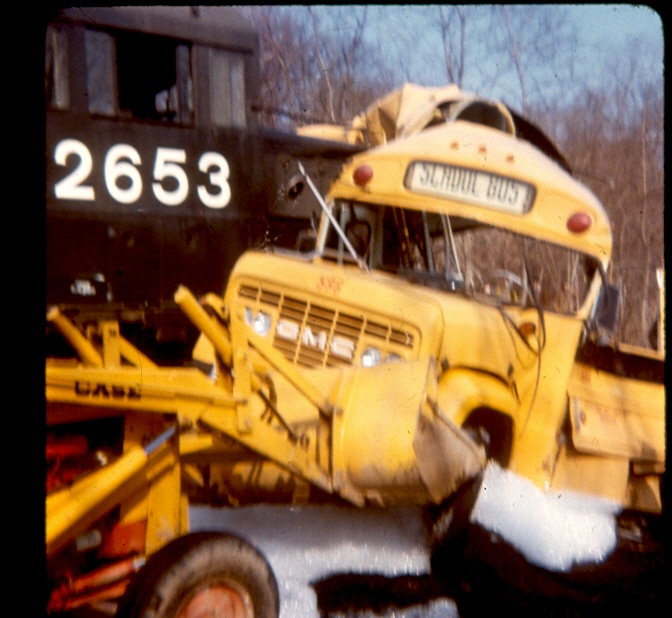








|

Penn Central Freight Train/School bus Collision
March 24, 1972.
About the New York train-school bus collision in 1972, history of the disaster and the cause.
TRAIN-SCHOOL BUS COLLISION
Loaded beyond capacity, school bus number 596 detoured downhill on Gilchrest
Road, in Congers, N.Y. At the bottom it would cross the Penn Central tracks. A
few minutes out of Congers, train number 2653 with 73 loaded freight cars was
also heading for Gilchrest Road. Fifteen hundred feet before the crossing, the
required warning blasts sounded from the diesel's air horns. The school bus
maintained its speed. There was a 2nd warning blast from the train, then
engineer Carpenter applied the air brakes, locking the train's wheels, but the
4,000-ton freight didn't respond. Seconds later there was a sickening crash.
When: At 7:55 A.M. on March 24, 1972.
Where: Congers, N.Y.
The Loss: Three students were killed out-right and of the 46 hospital-treated
victims, 2 more died. The bus had cost $8,000.
The Cause: Gilchrest Road crossing, like 2,400 others in New York State, had no
gate, watchman, bell system, or flashing lights. Trees bordered Gilchrest Road
right up to the crossing and though the part-time bus driver, 35-year-old Joseph
Larkin, had driven this alternate route for a week, there had been no trains.
Despite the tremendous responsibility, school bus drivers are underpaid. No
particular training is required, other than to pass a driving test. Because of
low salary, the turnover in bus drivers is high. It invites those who are out of
work temporarily, moonlighters, housewives who need part-time employment, and
retirees. All of these people are probably good neighbors and excellent drivers,
but they are not necessarily suited for a job that, at best, is a frustrating,
nerve-racking experience.
The morning of the disaster was a normal spring day. The weather was clear and
the bus had been checked for possible mechanical malfunctions. Train number 2653
was traveling at 25 mph and had sounded all required warnings. The collision
shouldn't have happened, but it did.
The Disaster: The Penn Central tracks curve before the straightaway approach to the Gilchrest Road crossing. Two long warning blasts, followed by one short and then another long blast, were sounded routinely. Headed downhill on Gilchrest Road, the yellow school bus could be plainly seen from the cab window of the diesel engine. There was plenty of open space before the crossing and so 2653 thundered onward. On the side of the tracks opposite the approaching school bus, William Muccio had stopped his garbage truck to await the train's passing. He could see that the bus was not slowing down. Transfixed, he watched the distance narrow between the train and the bus. In desperation he sounded his horn. It blended with another long blast from the diesel.
From the engine cab, the engineer, brakeman, and fireman watched the yellow bus hold its speed on a collision course. The engineer hit the air brakes praying they would stop his 4,000-ton juggernaut. Inside the bus, window-seat passengers pressed their fear-ridden faces against the glass, too frightened even to cry out.
The front diesel rammed the school bus just behind its center, tearing it in 2, tossing the back half upside down off the tracks. Seats, bodies, books, and papers flew in every direction. The front half wrapped itself around the front of the engine to be pushed 1,000' down the tracks. From the kitchen window of their home, a few hundred feet from the crossing, John, Joan, and Eileen Fitzgerald saw it happen. The only words spoken were John's. He kept repeating: "My God, the bus didn't stop! The bus didn't stop."
Photos By: Thomas T. Bierds